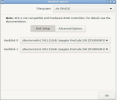Hello everyone
I been testing ZFS on NVME Drives.
Installed proxmox
on 2 NVME drives:
They are SN:
7VQ09JY9
7VQ09H02
Filesystem: ZFS Raid 1 (mirroring)

Reboot to installed proxmox and check:
zpool status -L
pool: rpool
state: ONLINE
config:
NAME STATE READ WRITE CKSUM
rpool ONLINE 0 0 0
mirror-0 ONLINE 0 0 0
nvme1n1p3 ONLINE 0 0 0
nvme0n1p3 ONLINE 0 0 0
errors: No known data errors
To explain which disk is which S/N
ls -l /dev/disk/by-id/ | grep nvme
- truncated----
nvme-Seagate_FireCuda_530_ZP1000GM30023_7VQ09H02 -> ../../nvme0n1
nvme-Seagate_FireCuda_530_ZP1000GM30023_7VQ09JY9 -> ../../nvme1n1
---------------
Now lets simulate failure of one drive. Lets say
(7VQ09H02 -> ../../nvme0n1 ) is dead now !
It's not problem got new one:
7VQ09HSX
Power off, Replaced disk, booting proxmox.
Checking:
root@smvm:~# zpool status -L
pool: rpool
state: DEGRADED
status: One or more devices could not be used because the label is missing or
invalid. Sufficient replicas exist for the pool to continue
functioning in a degraded state.
action: Replace the device using 'zpool replace'.
see: https://openzfs.github.io/openzfs-docs/msg/ZFS-8000-4J
config:
NAME STATE READ WRITE CKSUM
rpool DEGRADED 0 0 0
mirror-0 DEGRADED 0 0 0
nvme0n1p3 ONLINE 0 0 0
4351272091168832311 UNAVAIL 0 0 0 was /dev/disk/by-id/nvme-eui.6479a7823f0042a1-part3
errors: No known data errors
root@smvm:~#
There's new disk (serial 7VQ09HSX):
nvme-Seagate_FireCuda_530_ZP1000GM30023_7VQ09HSX -> ../../nvme1n1
nvme-Seagate_FireCuda_530_ZP1000GM30023_7VQ09HSX_1 -> ../../nvme1n1
nvme-Seagate_FireCuda_530_ZP1000GM30023_7VQ09HSX_1-part1 -> ../../nvme1n1p1
nvme-Seagate_FireCuda_530_ZP1000GM30023_7VQ09HSX-part1 -> ../../nvme1n1p1
We can replace UNAVAIL disk by
zpool replace -f rpool 4351272091168832311 /dev/disk/by-id/nvme-Seagate_FireCuda_530_ZP1000GM30023_7VQ09HSX
and we get:
root@smvm:~# zpool status
pool: rpool
state: ONLINE
scan: resilvered 1.33G in 00:00:02 with 0 errors on Mon Mar 18 14:49:30 2024
config:
NAME STATE READ WRITE CKSUM
rpool ONLINE 0 0 0
mirror-0 ONLINE 0 0 0
nvme-eui.6479a7823f004368-part3 ONLINE 0 0 0
nvme-Seagate_FireCuda_530_ZP1000GM30023_7VQ09HSX ONLINE 0 0 0
errors: No known data errors
root@smvm:~#
Seems fine, but problem is:
By default it was using partition3 on disk (7VQ09H02). We replaced it with nvme-Seagate_FireCuda_530_ZP1000GM30023_7VQ09HSX
as it point to physical disk, because new disk don't have any partitions.
New disk in pool nvme-Seagate_FireCuda_530_ZP1000GM30023_7VQ09HSX is now ONLINE but it doesn't boot.
How it is supposed to work ?
Do we need first dd if=oldremainingworkingdisk of=newblankdisk ?
And then add partition 3 of new disk as replace to resilver data, so new disk will be bootable ?
What's point installing proxmox on zfs raid disk as it doesn't provide "mirroring" out of box
and causes more problems for everyone who never faced drive failure.
I belive many users will get suprised when they get dead nvme disk, even with RAID1.
Can someone explain ?
I been testing ZFS on NVME Drives.
Installed proxmox
on 2 NVME drives:
They are SN:
7VQ09JY9
7VQ09H02
Filesystem: ZFS Raid 1 (mirroring)

Reboot to installed proxmox and check:
zpool status -L
pool: rpool
state: ONLINE
config:
NAME STATE READ WRITE CKSUM
rpool ONLINE 0 0 0
mirror-0 ONLINE 0 0 0
nvme1n1p3 ONLINE 0 0 0
nvme0n1p3 ONLINE 0 0 0
errors: No known data errors
To explain which disk is which S/N
ls -l /dev/disk/by-id/ | grep nvme
- truncated----
nvme-Seagate_FireCuda_530_ZP1000GM30023_7VQ09H02 -> ../../nvme0n1
nvme-Seagate_FireCuda_530_ZP1000GM30023_7VQ09JY9 -> ../../nvme1n1
---------------
Now lets simulate failure of one drive. Lets say
(7VQ09H02 -> ../../nvme0n1 ) is dead now !
It's not problem got new one:
7VQ09HSX
Power off, Replaced disk, booting proxmox.
Checking:
root@smvm:~# zpool status -L
pool: rpool
state: DEGRADED
status: One or more devices could not be used because the label is missing or
invalid. Sufficient replicas exist for the pool to continue
functioning in a degraded state.
action: Replace the device using 'zpool replace'.
see: https://openzfs.github.io/openzfs-docs/msg/ZFS-8000-4J
config:
NAME STATE READ WRITE CKSUM
rpool DEGRADED 0 0 0
mirror-0 DEGRADED 0 0 0
nvme0n1p3 ONLINE 0 0 0
4351272091168832311 UNAVAIL 0 0 0 was /dev/disk/by-id/nvme-eui.6479a7823f0042a1-part3
errors: No known data errors
root@smvm:~#
There's new disk (serial 7VQ09HSX):
nvme-Seagate_FireCuda_530_ZP1000GM30023_7VQ09HSX -> ../../nvme1n1
nvme-Seagate_FireCuda_530_ZP1000GM30023_7VQ09HSX_1 -> ../../nvme1n1
nvme-Seagate_FireCuda_530_ZP1000GM30023_7VQ09HSX_1-part1 -> ../../nvme1n1p1
nvme-Seagate_FireCuda_530_ZP1000GM30023_7VQ09HSX-part1 -> ../../nvme1n1p1
We can replace UNAVAIL disk by
zpool replace -f rpool 4351272091168832311 /dev/disk/by-id/nvme-Seagate_FireCuda_530_ZP1000GM30023_7VQ09HSX
and we get:
root@smvm:~# zpool status
pool: rpool
state: ONLINE
scan: resilvered 1.33G in 00:00:02 with 0 errors on Mon Mar 18 14:49:30 2024
config:
NAME STATE READ WRITE CKSUM
rpool ONLINE 0 0 0
mirror-0 ONLINE 0 0 0
nvme-eui.6479a7823f004368-part3 ONLINE 0 0 0
nvme-Seagate_FireCuda_530_ZP1000GM30023_7VQ09HSX ONLINE 0 0 0
errors: No known data errors
root@smvm:~#
Seems fine, but problem is:
By default it was using partition3 on disk (7VQ09H02). We replaced it with nvme-Seagate_FireCuda_530_ZP1000GM30023_7VQ09HSX
as it point to physical disk, because new disk don't have any partitions.
New disk in pool nvme-Seagate_FireCuda_530_ZP1000GM30023_7VQ09HSX is now ONLINE but it doesn't boot.
How it is supposed to work ?
Do we need first dd if=oldremainingworkingdisk of=newblankdisk ?
And then add partition 3 of new disk as replace to resilver data, so new disk will be bootable ?
What's point installing proxmox on zfs raid disk as it doesn't provide "mirroring" out of box
and causes more problems for everyone who never faced drive failure.
I belive many users will get suprised when they get dead nvme disk, even with RAID1.
Can someone explain ?
Last edited:

